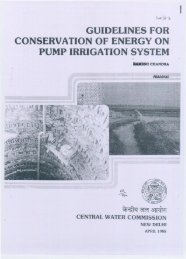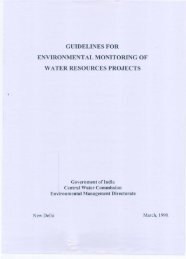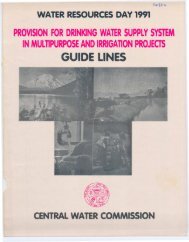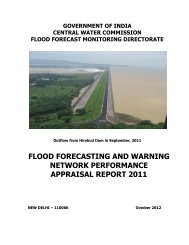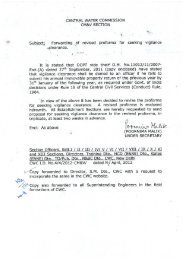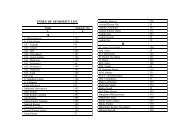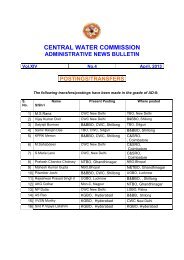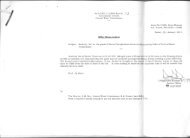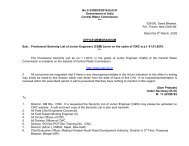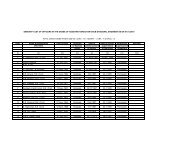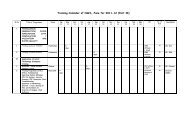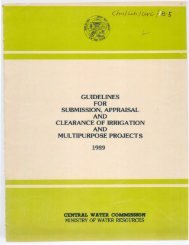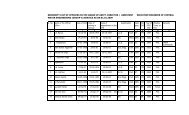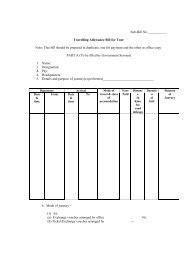Executive Summary - Central Water Commission
Executive Summary - Central Water Commission
Executive Summary - Central Water Commission
Create successful ePaper yourself
Turn your PDF publications into a flip-book with our unique Google optimized e-Paper software.
Project: ESA Study under DRIP to develop Environmental and Social Management Framework<br />
Page i<br />
Document: 2007069/EC/ July 2008<br />
<strong>Executive</strong> <strong>Summary</strong><br />
Revision: R2<br />
EXECUTIVE SUMMARY<br />
1.0 PROJECT BACKGROUND<br />
Over the years a large number of dams have been built all over India for development<br />
of water resources for irrigation, water supply, power generation and other benefits.<br />
Many of these dams are in urgent need of strengthening and rehabilitation to ensure<br />
their safety and to improve their performance. With this in view, Dam Safety Assurance<br />
and Rehabilitation Project (DSARP) was undertaken by the <strong>Central</strong> <strong>Water</strong> <strong>Commission</strong><br />
(CWC) with the World Bank (WB) assistance in 1991. There were four participating<br />
States, namely, Orissa, Rajasthan, Madhya Pradesh and Tamil Nadu. The objectives<br />
of DSARP were to:<br />
a) Strengthen the institutional framework for Dam Safety Assurance<br />
b) Provide basic safety facilities and take up remedial works for upgradation of<br />
selected dams.<br />
The project ended in 1999, but in view of the benefits obtained, it was decided to<br />
extend the dam safety activities to other States having significant number of major<br />
dams. DSARP Phase-II was thus conceived which included the States of Andhra<br />
Pradesh, Bihar, Gujarat, Karnataka, Kerala, Maharashtra and Uttar Pradesh. The<br />
DSARP Phase-II was later revised and updated as Dam Rehabilitation and<br />
Improvement Project (DRIP). The project development objective is to improve the<br />
safety and operational performance of selected existing dams. The proposed project<br />
deals with rehabilitation and modernization of existing dams. The purpose of the<br />
works is to prevent that the dams will operate under unsafe conditions due to<br />
prevailing safety issues. The project is now expected to be implemented in the<br />
following five states: Chhatisgarh, Kerala, Madhya Pradesh, Orissa, and Tamil Nadu<br />
A good number of dams, referred to as sub-projects, have been identified by the<br />
States for rehabilitation and upgradation under the DRIP. While reviewing the<br />
rehabilitation activities to be undertaken in each of the sub-projects, it was observed<br />
that a number of them could have potential environmental / social impacts which need<br />
to be taken care of during implementation of such activities. Hence, CWC, in<br />
consultation with the World Bank, decided to undertake environmental and social<br />
Final Report<br />
Environment & Ecology
Project: ESA Study under DRIP to develop Environmental and Social Management Framework<br />
Page ii<br />
Document: 2007069/EC/ July 2008<br />
<strong>Executive</strong> <strong>Summary</strong><br />
Revision: R2<br />
assessment of the sub-projects under consideration, in accordance with the relevant<br />
national and World Bank policies / guidelines.<br />
Since majority of the activities were found to be common among the sub-projects, it<br />
was further decided to undertake environmental and social assessment of the activities<br />
in ten representative sub-projects to identify the potential impacts and their mitigation<br />
measures and, based on this exercise, to develop an environmental and social<br />
management framework (ESMF). The framework will indicate the impacts of each<br />
activity, the required mitigation measures and the responsible entities for<br />
implementation, supervision and monitoring of the mitigation measures. It will also<br />
categorize the impacts in terms of low, medium and high. The ESMF will then be used<br />
by the concerned officials for screening of the sub-projects and for implementation,<br />
supervision and monitoring of the mitigation measures at appropriate levels.<br />
The ten representative sub-projects were selected from the States of Gujarat, Madhya<br />
Pradesh, Maharashtra and West Bengal. Environmental and social assessment of<br />
these sub-projects was carried out and an ESMF was developed, in accordance with<br />
the scope of the study.<br />
1.2 Scope of the Study<br />
The scope of the study required the following key issues to be covered:<br />
1. Review of the activities in the selected sub projects<br />
2. Review of Policy and Institutional Framework<br />
3. Environmental and Social Assessment of the selected sub projects<br />
4. Public Consultation<br />
5. Scoping and screening of impacts<br />
6. Development of an Environmental and Social Management framework.<br />
2.0 POLICY AND INSTITUTIONAL FRAMEWORK<br />
Policy and institutional framework of the Govt. of India as well as relevant safeguard<br />
policies of the World Bank with regard to environmental and social management of<br />
developmental projects were reviewed in the context of this study.<br />
Final Report<br />
Environment & Ecology
Project: ESA Study under DRIP to develop Environmental and Social Management Framework<br />
Page iii<br />
Document: 2007069/EC/ July 2008<br />
<strong>Executive</strong> <strong>Summary</strong><br />
Revision: R2<br />
The Government of India by specific legislations, regulates the environmental<br />
management of projects through the following Ministries / Statutory Bodies.<br />
<br />
<br />
<br />
<br />
The Ministry of Environment & Forests (MOEF)<br />
<strong>Central</strong> Pollution Control Board (CPCB)<br />
State Pollution Control Boards (SPCBs)<br />
Ministry / Department of Environment in the States<br />
The relevant policies / acts / notifications in this regard are:<br />
I. Environment Protection Act, 1986<br />
II. The Forest Conservation Act, 1980<br />
III. <strong>Water</strong> (Prevention and Control of Pollution) Act, 1974<br />
IV. The Air (Prevention and Control of Pollution) Act, 1981<br />
V. The National Rehabilitation and Resettlement Policy, 2007<br />
VI. Environmental Impact Assessment Notification, 2006<br />
The safeguard policies of the World Bank are given below:<br />
OP / BP 4.01: Environmental Assessment: The objective of this policy is to ensure<br />
that Bank financed projects are environmentally sound and sustainable<br />
OP/BP 4.04: Natural Habitats: The policy recognizes that the conservation of natural<br />
habitats is essential for long-term sustainable development. The Bank, therefore,<br />
supports the protection, maintenance and rehabilitation of natural habitats in projects<br />
funded by it. The Bank supports and expects the Borrowers to apply a precautionary<br />
approach to natural resources management to ensure environmentally sustainable<br />
development.<br />
OP 4.36: Forestry: This policy focuses on the management, conservation, and<br />
sustainable development of forest ecosystems and resources. It applies to projects<br />
which may have impacts on<br />
(a) The health and quality of forests;<br />
(b) The rights and welfare of people and their level of dependence upon forests. The<br />
Bank does not support significant conversion or degradation of critical forest areas /<br />
natural habitats.<br />
Final Report<br />
Environment & Ecology
Project: ESA Study under DRIP to develop Environmental and Social Management Framework<br />
Page iv<br />
Document: 2007069/EC/ July 2008<br />
<strong>Executive</strong> <strong>Summary</strong><br />
Revision: R2<br />
OP 4.09: Pest Management: The Policy encourages promotion and use of biological<br />
or natural pest control methods and reduced dependence on chemical pesticides.<br />
OP/BP 4.12: Involuntary Resettlement: The objective of this policy is to avoid or<br />
minimize involuntary resettlement, exploring all viable alternatives. Furthermore, it<br />
intends to assist displaced persons in improving their living standards; to encourage<br />
community participation in planning and implementation of resettlement; and to provide<br />
assistance to affected people, regardless of their legal status on the title of land.<br />
OP 4.10: Indigenous People: This policy aims to protect the dignity, right and cultural<br />
uniqueness of indigenous people; to ensure that they do not suffer due to<br />
development; and that they receive social and economic benefits of development.<br />
OP N 11.03: Cultural Property: The objective is to ensure preservation of cultural<br />
property in the project area. This includes preservation of archeological remains and<br />
unique environmental features.<br />
OP/BP 4.37: Safety of Dams: The policy requires that adequate measures are<br />
undertaken to ensure the safety of dams during its life cycle, both for new dams and<br />
dams taken up for rehabilitation and up-gradation.<br />
OP/BP 7.50: Projects on International <strong>Water</strong>s: This policy is applicable in case of<br />
dams on rivers with basins falling in more than one country.<br />
OP/BP 7.60: Projects in Disputed Areas: This policy is applicable where projects<br />
may affect relations between neighboring countries due to their location / operations.<br />
3.0 ENVIRONMENTAL AND SOCIAL ASSESSMENT<br />
The activities proposed in each of the ten representative sub-projects were studied<br />
and reviewed. A baseline survey was then carried out at each of the sub-projects to<br />
establish the existing environmental and social status. This included the study of<br />
physical, biological and socio-economic environment of the sub-projects and their<br />
surroundings, collection and study of secondary data, such as, meteorology, geology,<br />
Final Report<br />
Environment & Ecology
Project: ESA Study under DRIP to develop Environmental and Social Management Framework<br />
Page v<br />
Document: 2007069/EC/ July 2008<br />
<strong>Executive</strong> <strong>Summary</strong><br />
Revision: R2<br />
topography, flora & fauna, as well as, consultations with local communities and officials<br />
of <strong>Water</strong> Resources Department, Dam Safety Organisations, Irrigation, Fishery,<br />
Tourism and Power Departments of the concerned States. Details of consultations are<br />
discussed separately in the subsequent section.<br />
Environmental and social assessments of the sub-projects were then carried out for<br />
potential impacts and mitigation measures.<br />
4.0 Stakeholders and Public Consultation<br />
The process of consultation involved formal and informal discussion including<br />
individual interviews, and meetings with local villagers including women and other<br />
weaker sections of the communities, as well as, concerned officials of the following<br />
government departments:<br />
<strong>Central</strong> <strong>Water</strong> <strong>Commission</strong><br />
State <strong>Water</strong> Resources Department<br />
Agriculture Department<br />
Hydro Power Development Agencies<br />
Municipal Development Board<br />
Public Health Department<br />
State Forest Department<br />
Fishery Department<br />
Tourism Department<br />
4.1 Issues Discussed:<br />
A wide range of issues were discussed with various stakeholders which might have<br />
environmental / social concern. These are listed below.<br />
• Intensity of rainfall and inflow from the upstream<br />
• Downstream flooding problem due to dam water release.<br />
• Structural aspects of dams.<br />
• <strong>Water</strong> Quality and Siltation Problem<br />
• <strong>Water</strong> distribution and canal related problems<br />
• Local issues<br />
Final Report<br />
Environment & Ecology
Project: ESA Study under DRIP to develop Environmental and Social Management Framework<br />
Page vi<br />
Document: 2007069/EC/ July 2008<br />
<strong>Executive</strong> <strong>Summary</strong><br />
Revision: R2<br />
• Tourism potential<br />
• Hydro power generation<br />
• Land use pattern<br />
• Catchment Area Treatment<br />
• Rainfall monitoring and Alarm system<br />
• Environmentally sensitive areas in the vicinity<br />
• Fishing activity within the reservoir<br />
4.2 Major Findings and Recommendations<br />
• The Alarm system to warn the local people during emergency water release need<br />
improvement. The system relies on mobile phone service which depends on the<br />
efficiency of such service providers.<br />
• Adequate rainfall monitoring station be installed to assess the inflow from upstream<br />
in advance.<br />
• Promotion of fishing activities should be taken up within the reservoirs. A part of the<br />
revenue should go to the <strong>Water</strong> Resource Dept. towards maintenance of the dams.<br />
• There is good potential for tourism development with economic benefits for the locals.<br />
Development of suitable infrastructure is required for this purpose.<br />
• Siltation rate is quite high in some places affecting the storage capacity and water<br />
quality of the reservoir.<br />
• Catchment area treatment may be prioritized. Better coordination between the Forest<br />
Department and Irrigation Department may be ensured.<br />
• There are some major structural problem in some of the dams. Extension of<br />
guidewall and increase in the height of sill is required to minimize flooding effect in<br />
the immediate downstream and to protect the scouring of the stilling basin.<br />
• Canal systems need to be strengthened for better water distribution system and to<br />
minimize water loss.<br />
• Hydropower should be developed where potential exists.<br />
• Leakages in masonry work and choking of drains are major problems.<br />
Final Report<br />
Environment & Ecology
Project: ESA Study under DRIP to develop Environmental and Social Management Framework<br />
Page vi<br />
Document: 2007069/EC/ July 2008<br />
i<br />
<strong>Executive</strong> <strong>Summary</strong><br />
Revision: R2<br />
4.3 Assessment of key environmental and social issues:<br />
A few points that were identified during the environmental and social assessment of the<br />
sample of dams are summarized in more detail.<br />
Changes in water allocation upstream and downstream of project dams as a result of<br />
the project activities are not expected. The configuration of the dams will not change<br />
(no change in dam height, spillway crest level, etc.). Almost all dams do fill up now<br />
and spill, and this will continue after the project, but with a safer dam. As there are<br />
annual flood events there are limited opportunities to encroach on silted areas within<br />
the reservoir. Desilting of reservoir areas will not be a major activity under the project.<br />
There are only requests for possible desilting of a few State Electricity Board dams,<br />
and these are in remote areas where there is no encroachment.<br />
In the unlikely event that the remedial work on the dam requires land acquisition or<br />
resettlement, OP 4.12 on Involuntary Resettlement has been triggered. The ESMF<br />
already details the process to be followed for the preparation of a Resettlement Action<br />
Plan (RAP) in the event this may be required.<br />
There will be no change in reservoir volume for those dams that do spill already now.<br />
For the dams where the reservoir area is at the moment kept below full supply level for<br />
safety reasons, the rehabilitation works will allow a complete filing up afterwards,<br />
giving a positive impact (more water availability). Negative changes in overall water<br />
regime are therefore not expected. O&M manuals will be updated and the water<br />
delivery regime will be included.<br />
OP 4.10 on Indigenous Peoples has been triggered to address the eventuality that any<br />
sub-project dam is in a tribal area and the DRIP activity affects tribal populations. The<br />
ESMF already provides the procedure for preparation of an Indigenous People's<br />
Development Plan following all requirements of OP 4.10 that will include a process<br />
map for implementation which includes free, prior, and informed consultations with<br />
affected communities leading to broad-base community support for the intervention.<br />
Significant impact on livelihood systems as a result of the project interventions is not<br />
expected, but as needed this will be covered in the Plan.<br />
Although catchment rehabilitation was identified as an issue for some dams,<br />
addressing catchment management issues in a holistic way will not be carried out<br />
Final Report<br />
Environment & Ecology
Project: ESA Study under DRIP to develop Environmental and Social Management Framework<br />
Page vi<br />
Document: 2007069/EC/ July 2008<br />
ii<br />
<strong>Executive</strong> <strong>Summary</strong><br />
Revision: R2<br />
under the project, as it will involve many institutions, stakeholders, and a set of<br />
complex socio-economic issues. The proposed project interventions at the dams do<br />
not have any negative impact on the catchment areas, so it will not worsen the<br />
situation. If for the sustainability of rehabilitation and improvement of a dam, some<br />
catchment area treatment is seen as essential it can become part of the sub-project<br />
interventions.<br />
5.1 Identification of Activities<br />
Based on the analysis of the sub-projects, activities have been identified where<br />
environmental/social impacts need to be addressed. The activities taken into<br />
consideration are:<br />
1. Reservoir Desiltation,<br />
Activities identified for DRIP<br />
2. Tourism Development,<br />
3. Approach road, dam crest roads, etc. construction / improvement,<br />
4. Hydropower Generation,<br />
5. Standby Generator,<br />
6. River Regradation,<br />
7. Flood Protection Network,<br />
8. Wind Mill & Solar Power,<br />
9. Treatment of leakage through masonry and concrete dams and reduction of seepage<br />
through earth dams and their foundations,<br />
10. Improving Dam Drainage<br />
11 Structural strengthening of dams to withstand higher earthquake loads,<br />
12. Remodeling earth dams to safe, stable cross sections,<br />
13. Improving toe drain and seepage measuring devices,<br />
14. Improving ability to withstand higher floods including additional flood handling facilities, if<br />
needed,<br />
15. Repairs to damaged spillways, stilling basins and downstream channels,<br />
16. Improving dam safety instrumentation,<br />
17. Improving communications – real-time as much as possible – between dams, upstream<br />
rain/river flow gauging stations and with other dams, control offices and civil authorities in<br />
flood plains downstream of the dam,<br />
18. Flood marking,<br />
19. Low voltage electrical supplies in inspection and drainage galleries<br />
20. Improving lighting for external areas of dams,<br />
21. Inspection launches provision,<br />
22. Rehabilitation / Improvement of Spillway, head regulator and draw-off gates and their<br />
operating mechanisms,<br />
23. Repair / Modification of Spillway Gates,<br />
24. Cleaning of foundation drain & porous drain,<br />
25. Repair and cleaning of irrigation outlets<br />
Final Report<br />
Environment & Ecology
Project: ESA Study under DRIP to develop Environmental and Social Management Framework<br />
Page ix<br />
Document: 2007069/EC/ July 2008<br />
<strong>Executive</strong> <strong>Summary</strong><br />
Revision: R2<br />
Construction phase interventions, such as improvement of access roads, labor camps,<br />
silt disposal, and other ancillary temporary infrastructure may produce impacts on the<br />
communities in proximity. The ESMF does provide for addressing construction phase<br />
interventions, including how to deal with labor camps. The template discussed below<br />
will describe any major issues related to construction phase interventions that are<br />
identified at the investigation and pre-design phase. For example, in the rare instance<br />
there will be reservoir desilting, the design will have to determine the amount of silt and<br />
will have to prepare a specific plan where the silt will be desposited. The ESMF<br />
suffices to identify this as an environmental issue to be addressed during design and<br />
construction.<br />
There may be some dams which are near protected areas. As a rule, activities inside<br />
protected areas, such as borrow pits and building access roads, will not be allowed.<br />
Construction management plans will take into account the protected areas. If indeed<br />
the rehabilitation and improvement of a specific dam is in the vicinity of a protected<br />
area, as identified by the template, it will be ensured that a (partial) EA/EMP will be<br />
prepared.<br />
There are readily available, well-developed environmental specifications and it will be<br />
ensured that such specifications will indeed be included in the technical specifications<br />
of each tender document. The contractor will have to factor costs related to the<br />
implementation of environmental mitigation aspects in his bid. Site engineers will be<br />
instructed to supervise the compliance with the technical specifications, including the<br />
environmental clauses. As part of the third-party construction supervision and quality<br />
control, the Consultant will ensure compliance as well.<br />
For some dams the water levels in the reservoir will have to be brought down to<br />
facilitate repairs of the upstream face or carry out other works, which may temporarily<br />
disrupt release schedules. This is an aspect that will be taken into account during the<br />
design phase of the project. The technical guidance is that all alternative<br />
technologically and financially viable options which do not require or reduce reservoir<br />
draw-down will be taken into account. If it is unavoidable, the needed works will be<br />
planned during the period when the reservoir is at its lowest level, which is typically<br />
after the Rabi irrigation season and before the monsoons. The disruption to the water<br />
users will thus be minimal In the worst case, the project will be ready with a<br />
Final Report<br />
Environment & Ecology
Project: ESA Study under DRIP to develop Environmental and Social Management Framework<br />
Page x<br />
Document: 2007069/EC/ July 2008<br />
<strong>Executive</strong> <strong>Summary</strong><br />
Revision: R2<br />
communication strategy to inform the water users about temporary changes in water<br />
supply.<br />
5.2 Scoping<br />
In order to develop the ESMF for the identified activities, a scoping exercise was<br />
carried out to identify the components involved for execution of the activities. The<br />
components here signify the operational requirements for implementations of an<br />
activity in terms of manpower, machinery, materials (e.g. borrow/quarry materials etc)<br />
which are likely to cause environmental / social impacts. The components thus<br />
identified are listed below:<br />
Components Identified<br />
i. Acquisition of forest land, if any<br />
ii. Borrow materials/ area<br />
iii. Quarry materials / area<br />
iv. Blasting<br />
v. Dredging/Desiltation<br />
vi. Resettlement and Rehabilitation (anticipated in rare cases)<br />
vii. Labour Camps<br />
viii. Heavy machinery<br />
ix. Hot mix plant<br />
x. Concrete mixer and heavy pumps<br />
xi. Material handling and storage<br />
xii. Temporary land acquisition<br />
xiii. Tree felling/ vegetation clearance<br />
xiv. Haulage of machinery<br />
xv. Debris Disposal<br />
xvi. Transport of materials<br />
xvii. Small tools and pumps<br />
xviii. Sheds to keep machines and tools<br />
5.3 Categorisation of Components<br />
The components were categorized as A, B and C based on extent of adverse impacts<br />
Category A<br />
(major impact)<br />
Category B<br />
(Moderate impacts)<br />
Category C<br />
( Negligible impact)<br />
Acquisition of forest land Heavy machinery Small tools and<br />
Final Report<br />
Environment & Ecology
Project: ESA Study under DRIP to develop Environmental and Social Management Framework<br />
Page xi<br />
Document: 2007069/EC/ July 2008<br />
<strong>Executive</strong> <strong>Summary</strong><br />
Revision: R2<br />
Category A<br />
(major impact)<br />
Category B<br />
(Moderate impacts)<br />
Category C<br />
( Negligible impact)<br />
pumps<br />
Borrow materials/ area Hot mix plant Sheds to keep<br />
machines and tools<br />
Quarry materials / area Concrete mixture and heavy<br />
pumps<br />
Blasting Material handling and<br />
storage<br />
Dredging/Desilting of reservoir Temporary land acquisition<br />
Resettlement<br />
And<br />
Rehabilitation (anticipated in<br />
rare cases)<br />
Tree felling/ vegetation<br />
clearance<br />
Haulage of machinery<br />
Debris Disposal<br />
Transport of materials<br />
Labour Camps<br />
5.4 Screening<br />
A Screening exercise was then carried out to delineate the potential environmental<br />
and social impacts due to the components identified.<br />
6.0 ANALYSIS OF ALTERNATIVES<br />
An analysis was carried out for the sub-project activities to develop alternative<br />
scenarios which included no-project alternatives, no-component alternatives and withcomponent<br />
alternatives. The preferred alternative suggested is with-component<br />
alternative.<br />
7.0 ESMF<br />
The ESMF is the instrument that provides the necessary guidance to identify salient<br />
environmental and social issues early on, prepare, as needed, remedies and plans to<br />
address these issues, and monitor implementation. Keeping in view the specific<br />
requirements of ESMF, five forms have been developed. These forms will serve as<br />
reference material for use by the field officials/engineers to enable them to develop<br />
and impact sub-project specific ESMF. The forms are briefly described below.<br />
The 25 sub-project level activities identified for the development of the ESMF have<br />
been given in Form SC-1 for the purpose of identifying the activities relevant to a<br />
specific sub-project and screening out the other activities. The responsible entity at the<br />
dam level will carry out this task.<br />
Final Report<br />
Environment & Ecology
Project: ESA Study under DRIP to develop Environmental and Social Management Framework<br />
Page xi<br />
Document: 2007069/EC/ July 2008<br />
i<br />
<strong>Executive</strong> <strong>Summary</strong><br />
Revision: R2<br />
To identify the potential environmental / social impacts of an activity, the tasks and<br />
facilities required to be performed and provided for the activity are needed to be<br />
identified. These have been termed as components of an activity. A list of all possible<br />
components have been prepared and given in Form SC-2. For each activity, the<br />
components involved can be identified by dam level officials.<br />
Form SC-3 provides the identified sub-project activities in the first column, the<br />
components involved in the second column and potential impacts in the third column.<br />
Last two columns refer to implementation phase (I) and post-implementation phase<br />
(P).<br />
Based on potential environmental and social impacts associated with each component,<br />
these have been categorized as A, B and C and are given in Form SC-4.<br />
Category - A Components have major environmental / social impacts and require<br />
specific environment management plan (EMP) for implementation of mitigation<br />
measures. This EMP is to be incorporated in the bid document for the contractor /<br />
implementing agency to follow during implementation, as well as, post-implementation.<br />
Category - B Components have moderate environmental / social impacts and certain<br />
precautionary measures have to be followed by the contractor and the project<br />
authorities to minimize impacts during implementation as well as post-implementation.<br />
Category - C Components have negligible or nil environmental / social impacts and as<br />
such, no mitigation measures are proposed for these activities.<br />
Form SC-5 has been developed to identify mitigation measures for each type of<br />
potential environmental and social impacts. For ease of understanding and use, the<br />
components identified are given in the first column, corresponding potential impacts<br />
are given in the second column and corresponding mitigation measures are provided<br />
in the third column. The remaining three columns indicate the entities responsible for<br />
execution, supervision and monitoring of the mitigation measures, respectively.<br />
Final Report<br />
Environment & Ecology
Project: ESA Study under DRIP to develop Environmental and Social Management Framework<br />
Page xi<br />
Document: 2007069/EC/ July 2008<br />
ii<br />
<strong>Executive</strong> <strong>Summary</strong><br />
Revision: R2<br />
7.1 APPLICATION OF ESMF<br />
The ESMF may be used for sub-projects under the DRIP at the planning,<br />
implementation and post implementation phases to identify the environmental and<br />
social concerns, as well as, the opportunities to be addressed, so that these could be<br />
integrated in the relevant project documents.<br />
The organizational structure for DRIP consists of a Project Management Unit (PMU) at<br />
the <strong>Central</strong> level (at the <strong>Central</strong> <strong>Water</strong> <strong>Commission</strong> (CWC)), with one State level PMU<br />
for each of the 5 participating States. Each of these PMUs will include qualified<br />
Environmental and Social Development Specialists. The CPMU will be supported by a<br />
multi-disciplinary management and engineering consultant team (the Consultant) that<br />
will assist CWC with the overall implementation of the project. The Consultant’s team<br />
will include environmental and social specialists. The terms of reference include tasks<br />
related to environmental and social compliance. Some of the relevant tasks of the<br />
Consultant include: provide formal training to concerned staff at state, and central level<br />
to ensure that there is full awareness about environmental and social issues and the<br />
implementation of the ESMF; provide guidance and support to collect sufficient data at<br />
the investigation stage to determine the environmental and social impacts, if any,<br />
including whether stand-alone Environmental Assessments (EA) and Environmental<br />
Management Plans (EMP) are needed based on the outline provided in the ESMF; set<br />
up and monitor a reporting system that will show in a clear and transparent way<br />
whether there are any social and environmental issues related to the rehabilitation of<br />
the dams and the mitigation actions; provide guidance and support to the<br />
implementation of adequate monitoring of social and environmental parameters; and<br />
as part of the third-party construction supervision efforts, ensure that actions agreed to<br />
minimize environmental impact are being implemented.<br />
A template will be used that will require the concerned State level PMUs during the<br />
investigation and preliminary design stage for each dam to provide detailed information<br />
on technical, environmental, social, and all implementation-related aspects of each<br />
dam. The State level PMU will for each sub-project dam incorporate in the template<br />
the essential elements from the environmental and social screening templates<br />
prepared as part of the ESMF (refer to Forms above). The <strong>Central</strong> PMU, assisted by<br />
the Consultant, will carry out a first level screening of each template. The Consultant<br />
will develop and maintain a web-based MIS that will capture the information from the<br />
Final Report<br />
Environment & Ecology
Project: ESA Study under DRIP to develop Environmental and Social Management Framework<br />
Page xi<br />
Document: 2007069/EC/ July 2008<br />
v<br />
<strong>Executive</strong> <strong>Summary</strong><br />
Revision: R2<br />
templates. The Bank Task Team will receive and review each of the templates as<br />
well. Based on the review of the templates, a final categorization of each of the subproject<br />
dams will be made. Those that have no major environmental or social issues<br />
can have the designs finalized and be tendered. Only the few where there may be<br />
major environmental or social issues will require the preparation of a site specific<br />
EA/EMP. This template and the MIS will allow an early identification of those dams<br />
where major issues can be expected. There will then be additional supervision efforts<br />
for these dams.<br />
Schematic diagram for Execution of ESMF is given below.<br />
It may be mentioned here that though the sub-project activities for the development of<br />
this ESMF have been identified based on the analysis of such activities in a large<br />
number of dams proposed to be taken up for rehabilitation under the DRIP, this is a<br />
live document which can be improved upon at the sub-project level by the<br />
concerned authorities, as and when the need arises.<br />
Final Report<br />
Environment & Ecology
Project: ESA Study under DRIP to develop Environmental and Social Management Framework<br />
Page x<br />
Document: 2007069/EC/ July 2008<br />
v<br />
<strong>Executive</strong> <strong>Summary</strong><br />
Revision: R2<br />
Process<br />
Outcome<br />
Executing<br />
Responsibilities<br />
Supervising<br />
Responsibilitie<br />
Monitoring<br />
Responsibilities<br />
Planning Stage<br />
Screening of<br />
Activity (Form-<br />
SC-1)<br />
Screening of<br />
Components<br />
(SC-2)<br />
Impact<br />
Identification<br />
(Form- SC-3)<br />
Categorization<br />
of Components<br />
(Form- SC-4<br />
Identification of<br />
activities, components,<br />
adverse environmental<br />
and social impacts<br />
Categorization of<br />
components<br />
Enhanced awareness<br />
among the ID,<br />
stakeholders<br />
Formulation of subproject<br />
work plan that is<br />
finalized through<br />
stakeholder<br />
consultation and<br />
integrates social and<br />
environmental<br />
management plans<br />
Junior<br />
Engineer/<br />
Asst.<br />
Engineer<br />
<strong>Executive</strong><br />
Engineer<br />
Identification of<br />
Mitigation<br />
Measures (Form<br />
– SC-5)<br />
Budgets for<br />
implementation of<br />
social and<br />
environmental<br />
management plans<br />
Implementation<br />
Stage<br />
Documentation<br />
of Procedures<br />
(Implementation<br />
Plan)<br />
Implementation<br />
of Mitigation<br />
Measures<br />
Implementation<br />
of Monitoring<br />
Implementation of<br />
social and<br />
environmental<br />
management plans<br />
Monitoring and<br />
compilation of data on<br />
social and<br />
environmental<br />
parameters<br />
Enhanced relationship<br />
among the ID, the other<br />
stakeholders resulting<br />
in active participation in<br />
project implementation.<br />
Contractor<br />
Dam site incharge<br />
SWRD/<br />
SPCB/ Public<br />
Health<br />
Centre/<br />
District<br />
Collectorate/<br />
Tribes<br />
Advisory<br />
Post Implementation<br />
Stage<br />
Periodical<br />
Monitoring of<br />
Environmental<br />
and Social<br />
Indicators<br />
Completion of sub<br />
project activities in<br />
conformity with ESMF<br />
External<br />
Agency<br />
appointed by<br />
SWRD<br />
Dam site incharge<br />
SWRD/<br />
SPCB/ State<br />
Forest Dept<br />
ESMF Execution Plan<br />
Note: At central level an experienced environmental / social consultant may be<br />
engaged for supervision and monitoring of ESMF implementation in the state on behalf<br />
of CWC<br />
Final Report<br />
Environment & Ecology
Project: ESA Study under DRIP to develop Environmental and Social Management Framework<br />
Page x<br />
Document: 2007069/EC/ July 2008<br />
vi<br />
<strong>Executive</strong> <strong>Summary</strong><br />
Revision: R2<br />
In rare cases, development of a resettlement action plan may be called for, including<br />
relocation of cultural / common properties of the affected population. Similarly, tribal<br />
development plan may have to be prepared if a substantial section of the affected<br />
population are tribals.<br />
7.2 Monitoring and Evaluation Framework<br />
Monitoring and evaluation is primarily required to ensure proper and timely<br />
implementation of environmental and social mitigation measures identified in the<br />
planning stage, based on the ESMF. Monitoring at regular intervals during<br />
implementation and for a specified period in the post implementation stages is<br />
necessary to identify and implement any change / improvement needed in the<br />
execution of the activity or in the mitigation measures.<br />
A monitoring and evaluation cell may be created at State level under the supervision of<br />
an official familiar with environmental and social issues of the sub-projects. He may be<br />
given suitable training if needed. In specific situations, one may consider appointing<br />
external agencies to carry out the monitoring and evaluation activities and report to the<br />
supervising official. The indicators to be monitored can be framed from the ESMF<br />
taking into consideration the activities involved.<br />
The feedback received from monitoring and evaluation cell will be discussed with the<br />
implementing officials and the contractor and corrective actions will be taken, where<br />
necessary.<br />
7.2.1 Monitoring Budget<br />
A monitoring budget has been drawn up considering various environmental and social<br />
components. This provides cost for different mitigation measures of likely<br />
environmental/social impacts at sub-project level. Cost for environmental<br />
enhancement measures and monitoring has also been included. It also gives cost for<br />
plantation, enhancement of sites, and cost of monitoring.<br />
7.3 Training & Capacity Building<br />
The key to institutional reforms would be well-trained and motivated human resources.<br />
Competence levels of the departmental officials and their ability must be assessed and<br />
training in new skills provided. Cultural sensitivity, group dynamics, conflict resolution,<br />
Final Report<br />
Environment & Ecology
Project: ESA Study under DRIP to develop Environmental and Social Management Framework<br />
Page x<br />
Document: 2007069/EC/ July 2008<br />
vi<br />
<strong>Executive</strong> <strong>Summary</strong><br />
Revision: R2<br />
i<br />
leadership and ability to work with user population are as important as the engineering<br />
skills which are already in place. This will require the co-option into water resources<br />
department of social, gender and environmental subject matter specialists. This would<br />
also be an appropriate opportunity for assessing the capabilities of state training<br />
institutions, and enhance them if necessary. Enhanced training would also be required<br />
for local tribal population and women groups etc. The need and desirability of private<br />
sector participation should be assessed. The need for training equipment, computers,<br />
and software, training aids must be assessed, and procurement procedures should be<br />
initiated.<br />
7.4 Institutional arrangement<br />
Training and Capacity Building Strategy will form an integral part of the sub-project<br />
Plan and its implementation will be synchronized with other project interventions at<br />
different level. The responsibility of approving Training and Capacity Building Strategy<br />
as part of sub-project Plan will be with the PMU. The PMU will ensure that Training<br />
and Capacity Building Strategy conform to the agreed strategy of the project.<br />
Inter-sectoral coordination will be ensured at the Government (PMU), IDC and Project<br />
level through PMU. At the PMU level, a Project Steering Committee chaired by the<br />
Secretary and comprising of Chief Engineers of various IDCs and Project Divisions will<br />
provide inter-departmental coordination and strategic directions, decisions and support<br />
with a view to ensure timely and successful implementation of all project activities<br />
Training, awareness-raising, and capacity building strategies have been planned and<br />
factored into the project budget. The <strong>Central</strong> <strong>Water</strong> <strong>Commission</strong> will provide the<br />
necessary centralized support and facilities for the training and capacity building for<br />
different state level officers.<br />
8.0 ENVIRONMENT AND SOCIAL MANAGEMENT PLAN<br />
One of the requirement of the present study was to develop a sample environmental<br />
and social management plan (ESMP) to serve as a guide for preparation of a project<br />
specific ESMP. The sample ESMP is placed at chapter 8 in this report. It covers<br />
various aspects to be considered while preparing an ESMP, such as, management of<br />
dust and emissions, borrow and quarry areas, solid waste, labour camps, tribal<br />
Final Report<br />
Environment & Ecology
Project: ESA Study under DRIP to develop Environmental and Social Management Framework<br />
Page x<br />
Document: 2007069/EC/ July 2008<br />
vi<br />
<strong>Executive</strong> <strong>Summary</strong><br />
Revision: R2<br />
ii<br />
development, resettlement and rehabilitation. The ESMP also details monitoring<br />
requirements, institutional framework, training and capacity building aspects.<br />
Final Report<br />
Environment & Ecology



